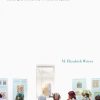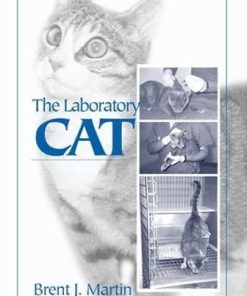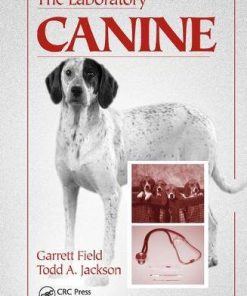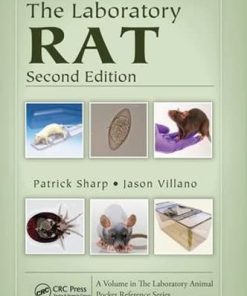The Laboratory Nonhuman Primate Laboratory Animal Pocket Reference 2nd Edition by Jeffrey Fortman, Terry Hewett, Lisa Halliday 1351643274 9781351643276
$50.00 Original price was: $50.00.$25.00Current price is: $25.00.
The Laboratory Nonhuman Primate Laboratory Animal Pocket Reference 2nd Edition by Jeffrey Fortman, Terry Hewett, Lisa Halliday – Ebook PDF Instant Download/Delivery: 1351643274, 9781351643276
Full dowload The Laboratory Nonhuman Primate Laboratory Animal Pocket Reference 2nd Edition after payment

Product details:
ISBN 10: 1351643274
ISBN 13: 9781351643276
Author: Jeffrey D. Fortman, Terry A. Hewett, Lisa C. Halliday
The Laboratory Nonhuman Primate Laboratory Animal Pocket Reference 2nd Table of contents:
- 1. important biological features
- introduction
- taxonomy
- Geographical Distribution
- Common Terms Used to Group Nonhuman Primates
- distinguishing features of New World monkeys
- distinguishing features of Old World monkeys
- New World monkeys commonly used in research
- Callitrichids
- Common or tufted marmoset
- Cotton-top tamarin
- Noncallitrichid New World Monkeys
- Squirrel monkeys
- Owl monkeys
- Old World monkeys commonly used in research
- Macaques
- Rhesus macaque
- Cynomolgus macaque
- Baboons
- Savanna baboons
- African Green Monkeys
- African green monkeys
- functional morphology
- Sexual Dimorphism
- Skull and Brain
- Back and Spine
- Limb Morphology
- Hand and Foot Morphology
- Digestive System
- Perineum
- Reproduction/Placentation/Growth and Development
- nonhuman primate sensory considerations
- Vision
- Smell and Taste
- Hearing
- Touch
- social structure
- Evolution of Social Living
- Nonhuman Primate Social Structures
- Solitary female and offspring
- Monogamous
- Single-male/multi-female groups
- Multi-male/multi-female groups
- Fission–fusion communities
- communication
- Scents
- Vocalization
- Allogrooming/Tactile Communication
- Visual Signals: Facial and Postural Communication
- aggressive and submissive behaviors
- Aggressive Behaviors
- Species-Specific Behaviors of Aggression or Dominance
- Submissive Behaviors
- normative reference values
- General Biological and Physiological Parameters
- Hematological Reference Values
- Clinical Chemistry Reference Values
- Blood Coagulation Values
- Blood Gas Analysis
- Tooth Eruption Times
- reproductive biology
- Sex Determination
- Reproductive Cycle
- Sex Skin
- Breeding Systems
- Pregnancy Diagnosis
- Parturition
- Postnatal Development
- references
- 2. husbandry
- introduction
- general housing and environmental considerations
- Facility Design Features
- Room Design Features
- Housing Systems
- Housing to allow postural and locomotor expression
- Sheltered or outdoor housing
- Space requirements
- Environmental Conditions
- Temperature and humidity
- Ventilation and air quality
- Illumination
- Noise
- environmental enrichment
- Nonnutritive Enrichment
- Nutritive Enrichment
- behavioral and social management
- Social Environment
- Pair housing
- Group housing
- Identification of compatibility
- Adjuncts to social housing
- Procedural Habituation and Training of Animals
- husbandry
- Food
- Novel Foods and Foraging Treats
- Water
- Bedding/Substrate
- Sanitation
- Equipment in Animal Housing Rooms
- Waste Disposal
- Pest Control
- Emergency, Weekend, and Holiday Care
- population management
- Permanent Methods of Identification
- Temporary Methods of Identification
- recordkeeping
- Individual Animal Medical Records
- Group/Colony/Breeding Records
- Records of Sedation, Anesthesia, and Perioperative Care
- Experimentally Induced Disease/Research Records
- Institutional Recordkeeping
- transportation
- Shipping Crates
- Health Certificates
- Certificates of Acquisition, Disposition, and Transport
- Certificates of Acclimation
- references
- 3. management
- introduction
- regulatory and accrediting agencies
- U.S. Department of Agriculture
- Public Health Service
- Food and Drug Administration and the Environmental Protection Agency
- Centers for Disease Control and Prevention
- U.S. Fish and Wildlife Service
- AAALAC International
- institutional animal care and use committee
- occupational health and safety
- Training
- Safe Work Practices
- Personal Protective Equipment
- Physical Injuries
- Macacine herpesvirus 1 (B virus) Exposure
- Allergic Reactions
- Experimental Hazards
- zoonoses
- Macacine herpesvirus 1 (B virus)
- Tuberculosis
- Bacterial Agents of Gastrointestinal Origin
- Protozoal Agents of Gastrointestinal Origin
- references
- 4. veterinary care
- preventative health program
- Sources
- Quarantine
- Quarantine facilities
- Quarantine husbandry practices
- Duration of quarantine
- Quarantine health surveillance
- Conditioned Colony Health Surveillance
- Daily observations
- Physical examination
- Tuberculin skin testing
- Adjunct tuberculosis screening tests
- Body weight and body condition assessment
- Immunization
- Separation of Species
- clinical management
- Basic Veterinary Supplies
- Clinical Signs of Illness in Nonhuman Primates
- Nutritional Support
- Therapeutic Agents
- common clinical problems
- Viral Diseases
- Measles
- Simian varicella
- Saimiriine herpesvirus 1 and Human herpesvirus 1
- Bacterial Diseases
- Tuberculosis
- Pneumonia
- Bloody nose syndrome
- Diarrhea
- Dermatitis
- Parasitic Diseases
- Gastrointestinal protozoal agents
- Gastrointestinal nematodes
- Behavioral Conditions
- Stereotypic behavior
- Self-injurious behavior
- Stress-induced diarrhea
- Alopecia
- Dental Care
- Examination of the oral cavity
- Gingivitis and periodontitis
- Dental prophylaxis
- Pulp exposure/tooth abscess
- Reproductive Conditions
- Endometriosis
- Dystocia
- Miscellaneous Conditions
- Traumatic injuries
- Obesity and diabetes mellitus
- Hypothermia
- Hypoglycemia
- Acute gastric dilatation/bloat
- anesthesia and analgesia
- General Principles
- Definitions
- Stages of general anesthesia
- Characteristics of anesthesia
- Anesthetic Management
- Anesthetic selection
- Patient care prior to anesthesia
- Patient care during anesthesia
- Patient monitoring
- Recordkeeping
- Patient care following anesthesia
- Anesthetic Agents
- Preanesthetic agents
- Intramuscular anesthetics
- Intravenous anesthetics
- Inhalant anesthetics
- Analgesic Agents
- Opioids
- Nonsteroidal anti-inflammatory agents
- Local anesthetics
- endotracheal intubation
- aseptic surgery
- Functional Areas/Equipment
- Personnel
- Surgeon and assistant
- Person administering anesthesia
- Circulating personnel
- Preoperative Preparation
- Surgical Sterilization Methods
- Operating Room Procedures
- Aseptic technique
- Intraoperative monitoring
- Postoperative Care
- Signs of pain
- Postoperative records
- Euthanasia
- references
- 5. experimental methodology
- introduction
- restraint
- Physical Restraint Methods
- Squeeze-back cages
- Transfer chutes and cages
- Nets
- Pole and collar restraint system
- Restraint stocks and tubes
- Restraint chairs
- Tether system
- Manual restraint
- Chemical Restraint Methods
- operant conditioning and training methods
- sampling techniques
- Blood Collection
- Blood collection sites
- Urine Collection
- Free-catch method
- Urethral catheterization
- Cystocentesis
- Bone Marrow Aspiration and Biopsy
- Cerebrospinal Fluid Collection
- Lumbar puncture
- Cisternal puncture
- Bronchoalveolar Lavage
- Rectal Biopsy
- Semen Collection
- Amniotic Fluid Collection
- compound administration
- Parenteral Administration Methods
- Intravenous administration
- Intramuscular administration
- Subcutaneous administration
- Intradermal administration
- Vascular access port (VAP)
- Osmotic pumps
- Oral Administration Methods
- Self-administration
- Orogastric and nasogastric gavage
- Orogastric gavage of capsules or tablets
- miscellaneous procedures
- Bimanual Rectal Palpation
- Necropsy
- references
- 6. resources
- introduction
- organizations and information resources
- publications
- Books
- Periodicals
- electronic resources
- primate sources
- Commercial Sources of Nonhuman Primates
- nonhuman primate transportation resources
- nonhuman primate transportation services
- laboratory services
- Genetic Analysis
- Infectious Agent Testing
- Adjunct Testing for Tuberculosis
- feed
- equipment and supplies
- Caging Equipment
- Capture/Blow Dart Systems
- Drug Delivery Systems
- Osmotic pumps
- Tether systems (jackets and swivels)
- Vascular access supplies
- Environmental Enrichment
- Restraint Systems
- Restraint chairs
- Restraint equipment (leather gloves, nets, poles, collars, and boxes)
- Sanitation Supplies
- veterinary equipment and supplies
- Anesthesia Equipment
- General Veterinary and Surgical Supplies
- Necropsy Equipment
- Syringes, Needles, and Catheters
- national primate research centers
- California National Primate Research Center
- Oregon National Primate Research Center
- Southwest National Primate Research Center
- Tulane National Primate Research Center
- Washington National Primate Research Center
- Wisconsin National Primate Research Center
- Yerkes National Primate Research Center
- other primate research centers
- Caribbean Primate Research Center
- Duke Lemur Center
- University of Oklahoma Health Sciences Center Baboon Research Resources
- Squirrel and Owl Monkey Breeding and Research Resource
- Vervet Research Colony
- equivalents and conversions
- Index
People also search for The Laboratory Nonhuman Primate Laboratory Animal Pocket Reference 2nd :
the laboratory nonhuman primate
the nonhuman primate in nonclinical drug development and safety assessment
the critical role of nonhuman primates in medical research
nonhuman primate
Tags:
Jeffrey Fortman,Terry Hewett,Lisa Halliday,Laboratory Nonhuman,Primate Laboratory
You may also like…
Uncategorized
Uncategorized
The Laboratory Rat Laboratory Animal Pocket Reference 2nd Edition Sharp Patrick Villano Jason S
Uncategorized
The Laboratory Hamster and Gerbil (Laboratory Animal Pocket Reference) 1st Edition Field
Biology and other natural sciences
The Laboratory Xenopus sp Laboratory Animal Pocket Reference 2nd Edition Green Sherril L
Uncategorized
Instruments & Measurements
The Laboratory Mouse (Laboratory Animal Pocket Reference) Third Edition Mark A. Suckow
Uncategorized











